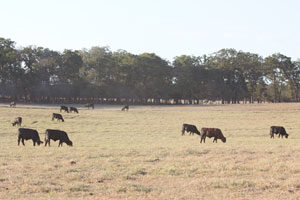Dr. David Anderson, AgriLife Extension livestock marketing economist in College Station, cited Texas Animal Health Commission out shipment data, which is the number of animals receiving veterinary inspection certificates prior to interstate movement.
"Out shipments are cattle moving out of state from Texas and they might also be called Texas' cattle exports to other states," he said. "Reported out shipments rose dramatically above 2010 in August-October. Total cattle reported shipped out of state in 2011 was 1.113 million head, 287,000 more than in 2010."
Nationally, beef cattle numbers continue to decline to historic levels. The U.S. Department of Agriculture reported Jan. 1 cattle inventory for all cattle and calves totaled 90.8 million head, 2 percent below the 92.7 million on Jan. 1, 2011. It is the lowest Jan. 1 inventory of all cattle and calves since the 88.1 million on hand in 1952, according to USDA.Texas, the nation's largest beef cow producing state, saw a decline in 2011, in the number of beef cows of 660,000, to 4.365 million head. "That's the smallest cow herd since 1960," Anderson said. "This decline was fueled by the drought, which left 2011 as the record holding driest year on record in Texas."
Cattle prices are predicted to continue to be at all-time highs. Retail beef prices are expected to remain high as well reflecting less supply, according to economists.
The USDA report revealed the national 2011 calf crop was estimated at 35.3 million head, down 1 percent from 2010. USDA reports it's the smallest calf crop since the 34.9 million born during 1950.
Slaughter numbers continued to escalate in 2011 due to drought, Anderson said. "The southwest region, which is Texas, New Mexico, Arkansas, Louisiana and Oklahoma, slaughtered almost 200,000 more beef cows in 2011 than the year before," he said. "Nationwide, beef cow slaughter numbers were up 170,000 head. And also fewer heifers were held back to enter the cow herds due to the dry conditions. Each of these contributed to the Texas's smaller cow herd."
Anderson said the decline in the nation¹s cattle herd continued the trend to fewer cattle that was kicked off by the sharp increase in costs that began in late 2006.
"Skyrocketing feed costs beginning in the fall of 2006 began a wave of herd culling as livestock producers nationwide tried to adjust to unprofitable conditions," Anderson said. "This herd liquidation was made even worse by the drought of 2011, the driest year on record in Texas."
The largest destination states for Texas breeding cattle were New Mexico, Nebraska, Florida, South Dakota and Kansas.
"There may be no surprise in the states farther north, but Florida and New Mexico may be surprising to some," Anderson said.
Top destinations for all Texas cattle outshipments were Kansas, Colorado, Oklahoma and Nebraska.
"Those states were also the top destinations for Texas cattle in 2010," he said. "The value in this data is certainly that it shows the general trends in cattle movements and highlights the effect of the drought in moving cattle numbers." ![]()
—Source: Texas AgriLife Extension Service
PHOTO
TOP RIGHT: More than 150,000 head of breeding cattle were shipped out of Texas in 2011 for greener pastures due to historic drought conditions. Staff photo.








